Coronavirus (COVID-19): modelling the epidemic (issue no. 59)
Latest findings in modelling the COVID-19 epidemic in Scotland, both in terms of the spread of the disease through the population (epidemiological modelling) and of the demands it will place on the system, for example in terms of health care requirement.
Coronavirus (COVID-19): modelling the epidemic in Scotland (Issue No. 59)
Background
This is a report on the Scottish Government modelling of the spread and level of Covid-19. This updates the previous publication on modelling of Covid-19 in Scotland published on 1st July 2021. The estimates in this document help the Scottish Government, the health service and the wider public sector plan and put into place what is needed to keep us safe and treat people who have the virus.
This edition of the research findings focuses on the epidemic as a whole, looking at estimates of R, growth rate and incidence as well as local measures of change in the epidemic.
In Scotland, the modelled estimate for R is between 1.2 and 1.5, with the growth rate between 3% and 7% based on the period up to 5th July. The R and growth rate indicators lag by two to three weeks, as a result the estimates cannot fully reflect the significant increase in daily cases seen over the past few weeks.
Following a recent upsurge, case numbers have started to fall back and there may be a plateau occurring. However there is considerable uncertainty about what this means for future weeks.
Key Points
- The reproduction rate R in Scotland is currently estimated as being between 1.2 and 1.5, based on the period up to 5th July. This is unchanged from last week.
- The number of new daily infections for Scotland is estimated as being between 89 and 124, per 100,000 people, based on the period up to 5th June.
- The growth rate for Scotland is currently estimated as being between 3% and 7%, based on the period up to 5th June. This is unchanged from last week.
- Average contacts have remained at a similar level in the last two weeks (comparing surveys pertaining to 10th June - 16th June and 24th June - 30th June) with a current level of 4.2 daily contacts.
- Contacts within the work setting have decreased by 15% compared to two weeks prior and contacts within the other setting (contacts outside of the school, home and work) have increased by 7%. Average contacts within the home setting have remained at similar levels over the same period.
- Mean contacts across all age groups remain around similar level in comparison to two weeks prior with the exception of those aged between 18-29 who have decreased their contacts by 29% which is largely driven by reductions in contacts within the work setting.
- Mean contacts within the other setting is the only setting to show an increase over the same period, with all other settings reporting a decrease in overall mean contacts.
- The biggest increase in interactions is seen with those aged between 30-49 with those aged under 18 whereas the biggest decrease is with those aged between 18-29 with those 5-12.
- The proportion of participants visiting different locations remains at similar levels across all locations with those using public transport reporting the highest increase from 18% to 21% in the last two weeks.
- Based on the recent increase in cases, infections, hospital beds and ICU are projected to rise – for how long this continues is uncertain.
- Modelled rates of positive tests per 100K using data to 5th July indicate that for the week commencing 18th July 2021, there are 26 local authorities with at least a 75% probability of exceeding 150 cases per 100k.
- Of these, 9 local authorities have at least a 75% probability of exceeding 500 cases per 100k (Fife, Dundee, Glasgow, Perth & Kinross, Renfrewshire, East Dunbartonshire, North Lanarkshire, West Lothian and Aberdeen). Fife is the only local authority with at least a 75% probability of exceeding 1000 cases per 100k.
- Overall, wastewater (WW) Covid-19 levels continued to rise rapidly, reaching the highest levels observed. Increases are seen in a broad range of local authorities.
- The highest WW Covid-19 values were seen at the Seafield site, which covers Edinburgh. The reading on 2nd July is almost twice as high as the previous peak in the area. Of the sites that gave WW Covid-19 measurements in the last week, only Stornoway gave negative viral test results.
Recent increase in cases
Figure 1 shows the number of cases reported in Scotland during May and June 2021, including the recent increase in cases seen in the last week. The vertical dashed lines indicate the cut off points for each of the modelling inputs; after these dates, the number of cases is not incorporated into the outputs.
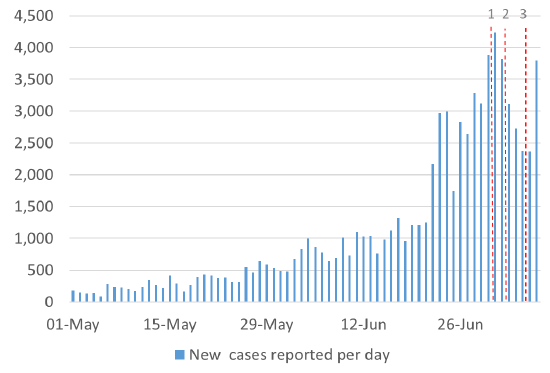
This report covers the period up to 30th June for contact patterns (indicated by dashed line 1). Wastewater data is provided to 2nd July (dashed line 2). The estimates of R, incidence, growth rates, the modelled rates of positive tests per 100k, and the medium term projections by the Scottish Government of infections, hospitalisations and ICU beds use data to 5th July (dashed line 3).
Overview of Scottish Government Modelling
Modelling outputs are provided here on the current epidemic in Scotland as a whole, based on a range of methods. Because it takes a little over three weeks on average for a person who catches Covid-19 to show symptoms, become sick, and either die or recover, there is a time lag in what our model can tell us about any re-emergence of the epidemic and where in Scotland this might occur.
However modelling of Covid-19 deaths is an important measure of where Scotland lies in its epidemic as a whole. In addition, the modelling groups that feed into the SAGE consensus use a range of other data along with deaths in their estimates of R and the growth rate. These outputs are provided in this research findings. The type of data used in each model to estimate R is highlighted in Figure 2.
We use the Scottish Contact Survey (SCS) to inform a modelling technique based on the number of contacts between people. Over time, a greater proportion of the population will be vaccinated. This is likely to impact contact patterns and will become a greater part of the analysis going forwards.
The logistical model utilises results from the epidemiological modelling, principally the number of new infections. The results are split down by age group, and the model is used to give a projection of the number of people that will go to hospital, and potentially to ICU. This will continue to be based on both what we know about how different age groups are affected by the disease and the vaccination rate for those groups.
What the modelling tells us about the epidemic as a whole
The various groups which report to the Scientific Pandemic Influenza Group on Modelling (SPI-M) use different sources of data in their models (i.e. deaths, hospital admissions, cases) so their estimates of R are also based on these different methods.
R is an indicator that lags by two to three weeks and therefore does not reflect any behavioural changes that have happened during this time. In particular, Scotland has seen a significant increase in the number of new daily cases over the past few weeks and the associated R and growth rate estimates will not yet fully reflect this.
SAGE's consensus view across these methods as of 7th July, using data to 5th July, was that the value of R in Scotland was between 1.2 and 1.5 (see Figure 2)[1].
This week the Scottish Government presented two outputs to SPI-M. The first uses confirmed cases as published by Public Health Scotland (PHS). The second uses instead wastewater data to estimate the number of cases. Both outputs are shown in Figures 2 and 3.
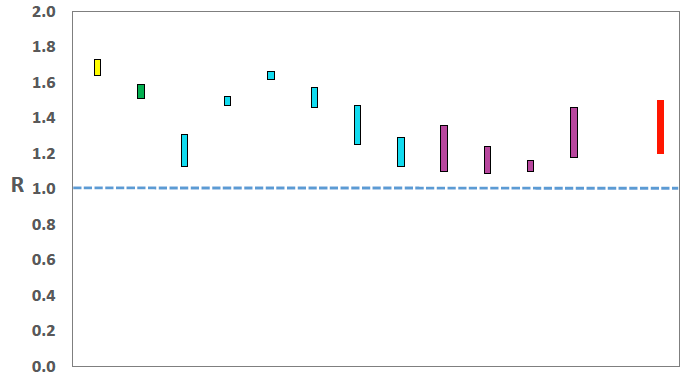
Source: Scientific Advisory Group for Emergencies (SAGE).
The various groups which report to the Scientific Pandemic Influenza Group on Modelling (SPI-M) use different sources of data in their models to produce estimates of incidence (Figure ). SPI-M's consensus view across these methods, using data to 5th July, was that the incidence of new daily infections in Scotland was between 89 and 124 new infections per 100,000. This equates to between 4,900 and 6,800 people becoming infected each day in Scotland.
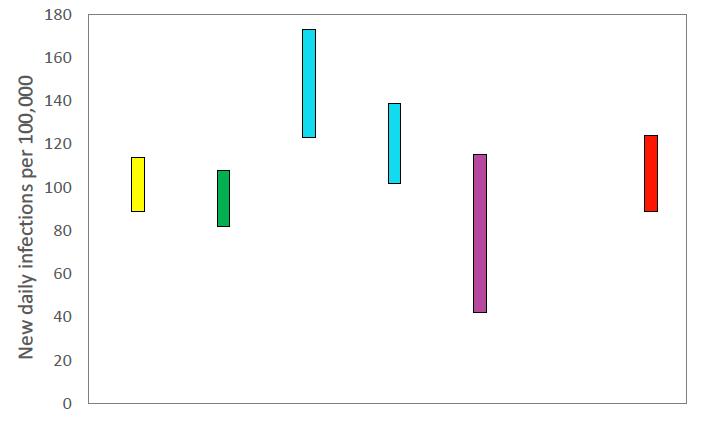
Source: Scientific Pandemic Influenza Group on Modelling (SPI-M).
The consensus from SAGE for this week is that the growth rate in Scotland is between 3% and 7% per day using data to 5th July. This is unchanged from last week.
What we know about how people's contact patterns have changed
Average contacts have remained at a similar level in the last two weeks (comparing surveys pertaining to 10th June - 16th June and 24th June - 30th June) with a current level of 4.2 daily contacts as seen in Figure 4. Contacts within the work setting have decreased by 15% compared to two weeks prior and contacts within the other setting (contacts outside of the school, home and work) have increased by 7%. Average contacts within the home setting have remained at similar levels over the same period.
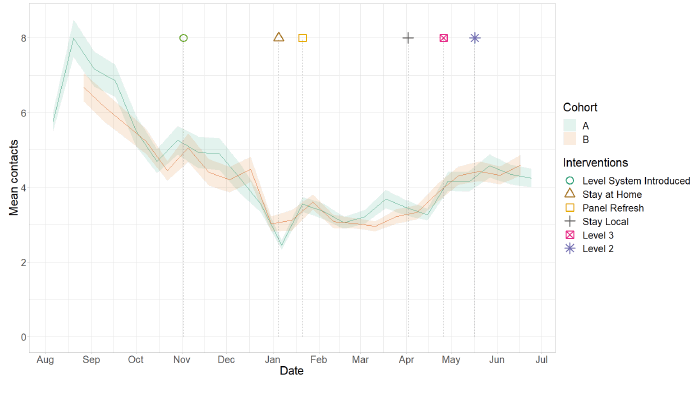
Figure 5 shows how contacts change across age group and setting. Mean contacts across all age groups remain around similar level in comparison to two weeks prior with the exception of those aged between 18-29 who have decreased their contacts by 29% which is largely driven by reductions in contacts within the work setting. Mean contacts within the other setting is the only setting to show an increase over the same period, with all other settings reporting a decrease in overall mean contacts.
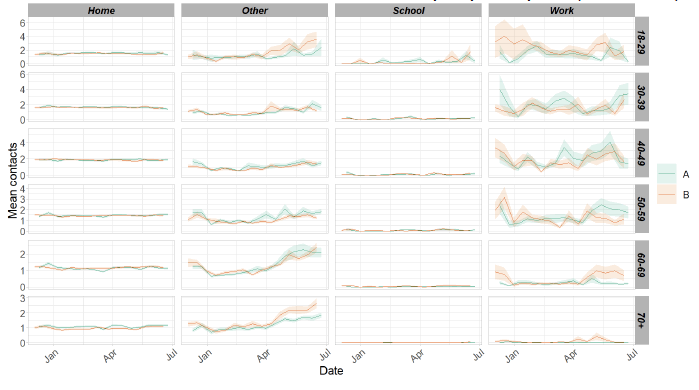
The heatmaps in Figure 6 show the mean overall contacts between age groups for the weeks relating to 10th June - 16th June and 24th June - 30th June and the difference between these periods. The biggest increase in interactions is seen with those aged between 30-49 with those aged under 18 whereas the biggest decrease is with those aged between 18-29 with those 5-12.
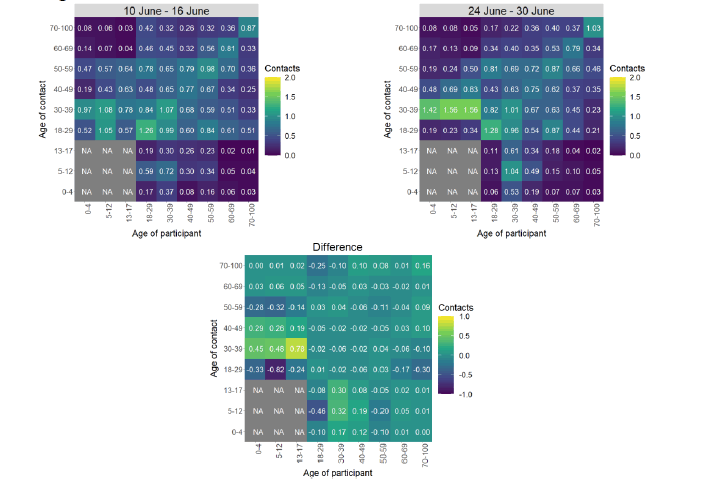
As seen in Figure 7, the proportion of participants visiting different locations remains at similar levels across all locations with those using public transport reporting the highest increase from 18% to 21% in the last two weeks.
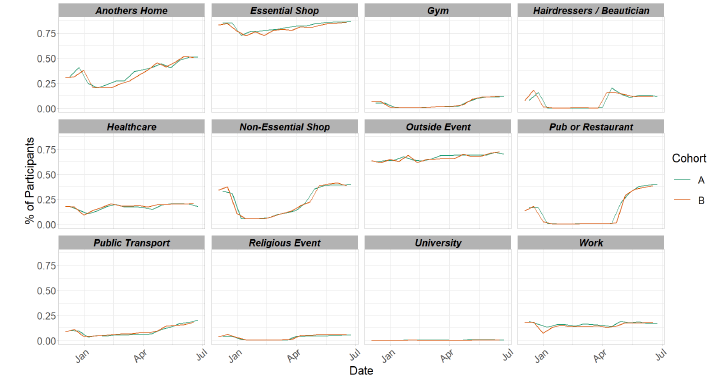
Vaccinations and contacts patterns
From Figure 8, it can be seen that the older age groups have fewer contacts and more vaccinations than the younger age groups. They also have the lowest weekly case number comparatively to the younger age groups. Despite that, they have similar, or higher for the oldest age group, weekly hospitalization levels to that seen with the younger age groups.
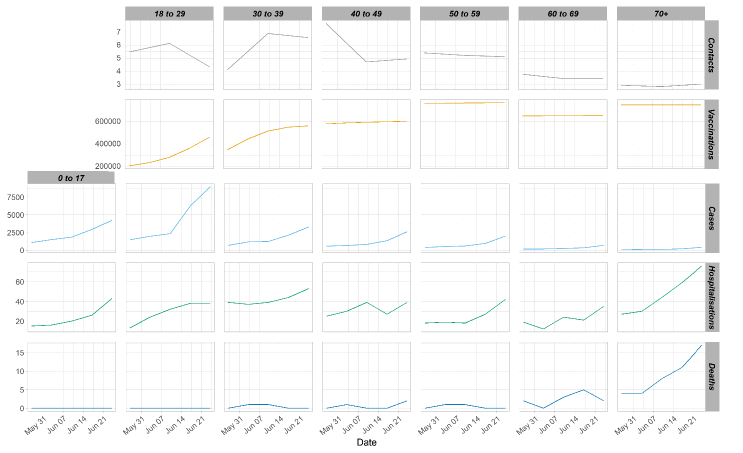
What the modelling tells us about estimated infections as well as Hospital and ICU bed demand
The Scottish Government assesses the impact of Covid-19 on the NHS in the next few weeks in terms of estimated number of infections. Figure 9 shows two projections. 'Worse' is based on a slightly higher transmission rate than was observed last week. 'Better' is based on a slightly lower transmission rate than was observed last week.[5]
The whole of Scotland will move to Level 0 on 19th July if all necessary vaccination and harm reduction measures are met. As such, we are only providing projections until this date.
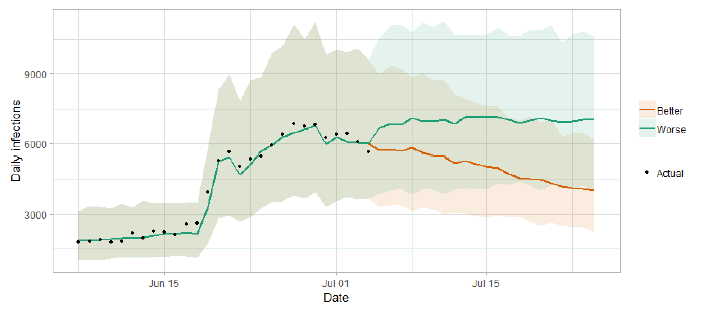
There is uncertainty as to whether infections will remain level or will reduce in coming weeks. This will drive whether hospital beds and intensive care beds also continue to rise.
Figure 10 shows the impact of the projections on the number of people in hospital. The modelling includes all hospital stays, whereas the actuals only include stays up to 28 days duration that are linked to Covid-19. Work is ongoing to show the modelled occupancy for stays up to a 28 day limit.
The increase in cases seen in the last weeks is likely to lead to a continuing increase in hospitalisations and intensive care use, with considerable uncertainty as to future weeks.
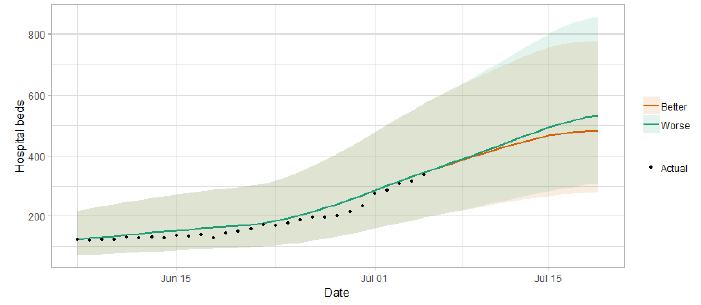
Figure 11 shows the impact of the projection on ICU bed demand.
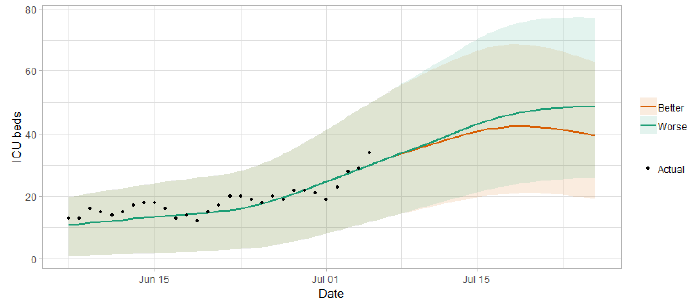
A comparison of the actual data against historical projections is included in the Technical Annex.
What the modelling tells us about projections of hospitalisations and deaths in the medium term
SAGE produces projections of the epidemic[8] (Figure 12), combining estimates from several independent models (including the Scottish Government's logistics modelling, as shown in Figures 9-11). These projections are not forecasts or predictions. They represent a scenario in which the trajectory of the epidemic continues to follow the trends that were seen in the data up to 5th July and do not include the effects of any future policy or behavioural changes.
The delay between infection, developing symptoms, the need for hospital care, and death means they will not fully reflect the impact of behaviour changes in the two to three weeks prior to 5th July. Projecting forwards is difficult when the numbers of cases, admissions and deaths fall to very low levels, which can result in wider credible intervals reflecting greater uncertainty. The interquartile range can be used, with judgement, as the projection from which estimates may be derived until the 19th July, albeit at lower confidence than the 90% credible interval.
These projections include the potential impact of vaccinations over the next few weeks. Modelling groups have used their expert judgement and evidence from Public Health England, Scottish Universities & Public Health Scotland, and other published efficacy studies when making assumptions about vaccine effectiveness.
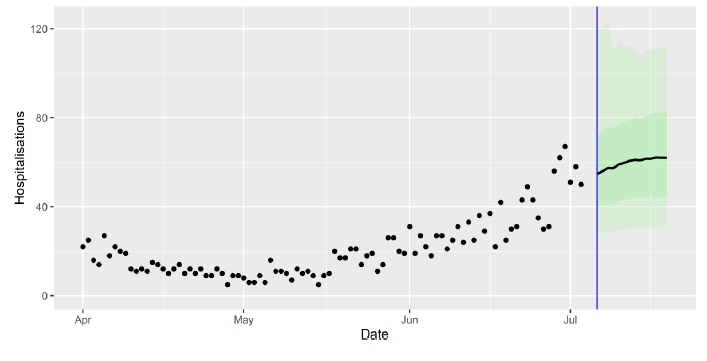
We are not projecting the numbers of people expected to die with Covid‑19 this week. The number of daily deaths has fallen to very low levels. Projecting forwards is difficult when numbers fall to very low levels, therefore SPI-M-O have decided to pause producing medium term projections for daily deaths in Scotland. SPI‑M‑O's consensus view is that the number of deaths will remain low over the next few weeks.
What we know about which local authorities are likely to experience high levels of Covid-19 in two weeks' time
We continue to use modelling based on Covid-19 cases and deaths using data to 5th July from several academic groups to give us an indication of whether a local authority is likely to experience high levels of Covid-19 in the future. This has been compiled via SPI-M into a consensus. In this an area is defined as a hotspot if the two week prediction of cases (positive tests) per 100K population is predicted to exceed a threshold, e.g. 500 cases.
Modelled rates of positive tests per 100K using data to 5th July (Figure 13) indicate that, for the week commencing 18th July 2021, there are 26 local authorities with at least a 75% probability of exceeding 150 cases per 100k[9].
Of these, 9 local authorities have at least a 75% probability of exceeding 500 cases per 100k. These are Fife, Dundee, Glasgow, Perth & Kinross, Renfrewshire, East Dunbartonshire, North Lanarkshire, West Lothian and Aberdeen.
Fife is the only local authority with at least a 75% probability of exceeding 1000 cases per 100k[10].
The local authority level modelling and national level modelling from SPI‑M are based on different groups of models and look at different metrics. Furthermore the local level modelling is produced a day later than the national level. As a result, the local authority level and national level modelling do not exactly correspond to each other.
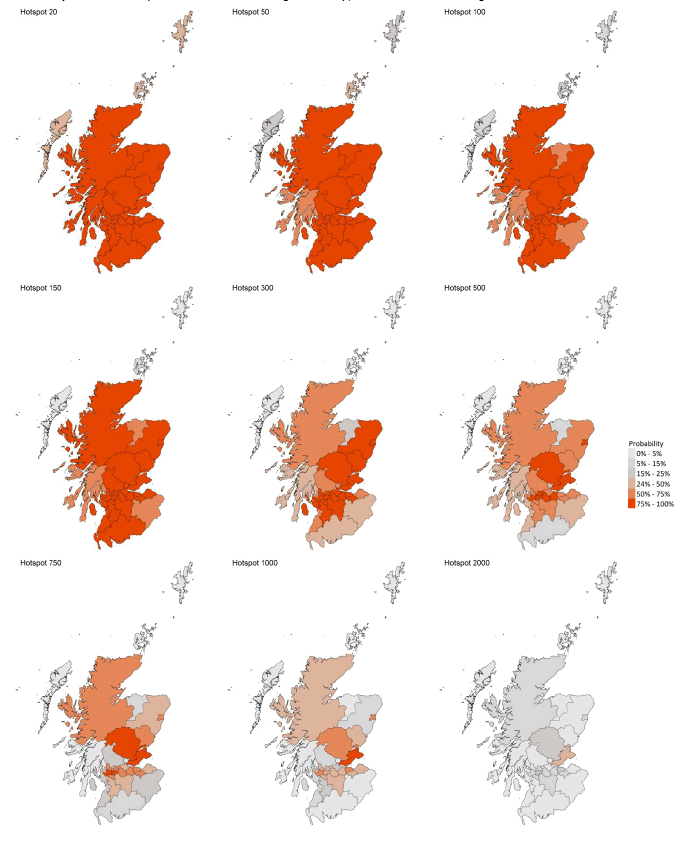
What can analysis of wastewater samples tell us about local outbreaks of Covid-19 infection?
Levels of Covid-19 RNA in wastewater collected at a number of sites around Scotland are adjusted for population and local changes in intake flow rate and compared to daily 7-day average positive case rates derived from Local Authority and Neighbourhood (Intermediate Zone) level aggregate data. See Technical Annex in Issue 34 of these Research Findings for the methodology.
Nationwide, wastewater (WW) Covid-19 levels continued to rise rapidly, reaching over 65 million gene copies per person per day (Mgc/p/d), equalling the highest levels observed. Increases are seen in a broad range of local authorities.
Figure 14 shows the national aggregate for the original 28 sites (in blue) and, from January 2021, the aggregate for the full set of sampled sites (in green), with a small number of unrealistically large outliers excluded. WW Covid-19 rose at roughly the same rate as case rates, though levels amongst the original 28 sites rose faster still, partly due to a very high measurement at the Seafield wastewater treatment works in Edinburgh (Figure 16).
Of the sites that gave WW Covid-19 measurements in the last week, only Stornoway gave negative viral test results. Over 28% of sites gave levels higher than 50 Mgc/p/d.
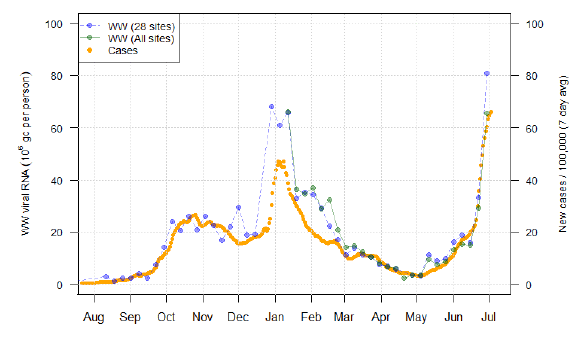
Figure 15 uses colours to map (i) the local authority average viral RNA levels (in Mgc/p/d) over the two-week period from 19th June to 2nd July, and (ii) the change in viral RNA levels compared to the previous two week period 5th June to 18th June. We see a general increase in levels over this period. The highest increases are seen in the major cities of Edinburgh, Aberdeen, and Dundee, as well as Fife.
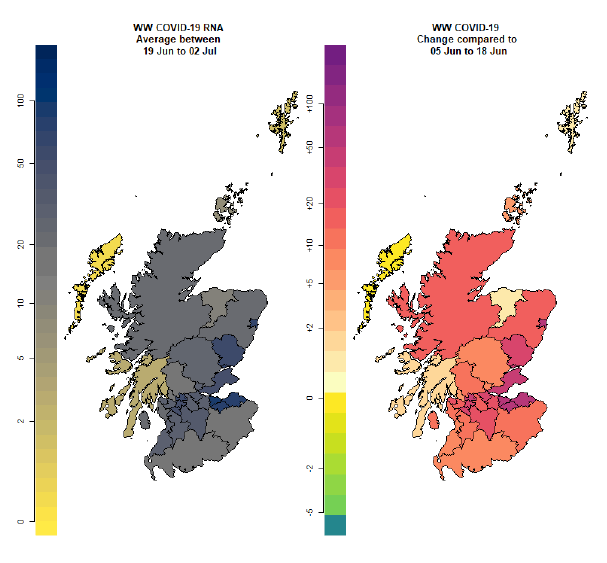
The highest WW Covid-19 values were seen at the Seafield site, which covers the City of Edinburgh (Figure 16). Here, a reading of 94 Mgc/p/d, roughly in line with case rates, was eclipsed by a reading of 193 Mgc/p/d on 2nd July. This new reading is almost twice as high as the previous peak in the area, but the fact that it falls in line with current trends in WW viral levels and coincides with an increase (albeit lesser in magnitude) of case rates makes it unlikely to be an anomalous result.
In addition to the major cities, we also saw especially large increases in Fife, in particular at Kirkcaldy (Figure 17) and Levenmouth, as well as at Inverclyde.
Please note that the number of cases shown is the daily moving average of cases per 100k. This is used as part of the normalisation process for WW.
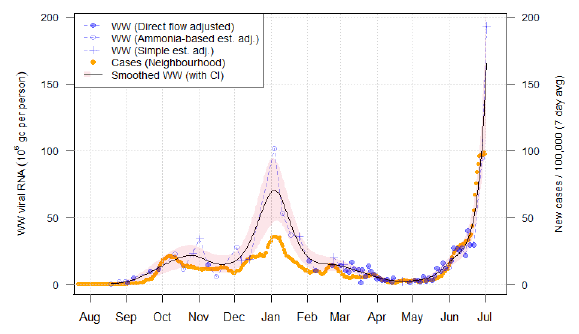
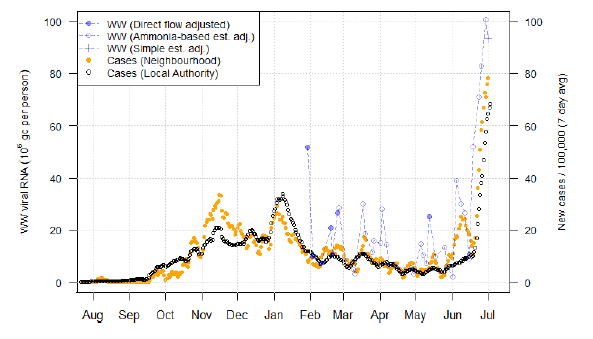
It is notable that in some sites, WW Covid-19 remains low even as cases continue to increase. Persistently low WW Covid-19 levels are found at sites like Ardoch, Fairlie, and Helensburgh. At Helensburgh, WW Covid‑19 has remained at or below 5 Mgc/p/d even as cases rose above 30 new cases per day per 100k inhabitants. This is especially surprising given that in the past, WW levels at that site were very high in comparison to case numbers. Individual low WW measurements are also found at sites like Galashiels and Dalbeattie. All these sites however do give positive test results.
What next?
The modelled estimates of the numbers of new cases and infectious people will continue to be provided as measures of the epidemic as a whole, along with measures of the current point in the epidemic such as Rt and the growth rate. Further information can be found at https://www.gov.scot/coronavirus-covid-19.
We may report on exceedance in future weeks when the background levels of Covid-19 reduces so that it can be useful in identifying outbreaks.
Contact
There is a problem
Thanks for your feedback